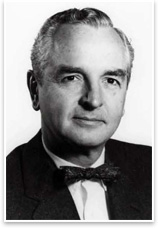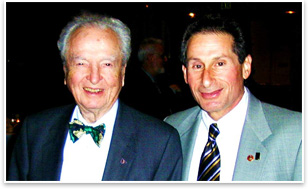
|
In Memory, Rex Whitaker Allen, 1914–2008
Summary: Rex Whitaker Allen, the 1969–’70 AIA president and architect/author who played a major role in reshaping health-care facility design, died April 7. He was 93.
Born in San Francisco and raised in New England, Allen received an AB from Harvard in 1936. He spent a year at the Columbia Architectural School before returning to Harvard’s Graduate School of Design, from which he received his MArch degree in 1939. After graduation, he worked in several offices on the East Coast, including that of Isadore Rosenfield, a hospital architect. He returned to San Francisco in 1949 and, four years later, opened his own office. After he launched his firm in 1953, it became obvious that his interests and talents were in the complexities of health-care design. As the firm grew, it became Rex Whitaker Allen and Associates in 1961, the Rex Allen Partnership in 1971, and Rex Allen-Drever-Lechowski in 1976. Allen’s firm designed more than 100 hospitals, 10 of which received national awards. One of his first significant projects was a 100-bed addition to the Roseville District Hospital in 1956. Other hospital projects were the French Hospital in San Francisco, Alta Bates in Berkeley, Long Beach Community Hospital, and Woodland Memorial Hospital. At the Dominican Hospital in Santa Cruz, Allen’s firm pioneered the use of interstitial space for the mechanical and electrical systems, and his contributions to the development of the patient “duo-room” and the nurse server unquestionably had a significant impact on hospital design. From 1971 through 1976, he worked with Hugh Stubbins on the design and construction of the outpatient building for Boston City Hospital. He worked on programming and design for facilities in Oregon, Michigan, and Saipan and was a consultant for facilities at the University of São Paulo and the city of Campinas in Brazil, as well as in Agana, Guam, and Seoul, Korea. Allen is the author of one of the first major books on health-care facility design, the Hospital Planning Handbook (John Wiley & Sons, 1976) and numerous articles published in such journals as World Hospital, AIA Journal, Consulting Engineer, Architectural Record, American Journal of Nursing, and Hospital Management. He is also credited with humane design interventions for the nursing home. Steven Verderber and David Fine, in their book, Healthcare Architecture in an Era of Radical Transformation, wrote that Allen “was one of the first architects to call for a residentially driven alternative to the hospital-driven modern nursing home.” Writing of Allen’s pioneering work in designing specialized facilities for health care, including for Alzheimer’s patients, the authors added that “Allen and others were working to reinvent the nursing home. Their approach included varied ceiling forms, residential roofs, undulating corridors, inviting dayrooms and commons areas, and a more residential scale in keeping with the use of residential materials where possible and allowed for by codes.”
A lifetime of AIA service On the national level, Allen served as vice president of the AIA, 1964–66; secretary, 1966–68; first vice president, 1968– 69; and president from June 1969 to December 1970. A change in the AIA bylaws in 1969 stated that “officers shall take office upon the adjournment of the annual meeting of the Board of Directors next following their election, which meeting shall take place in November or December of each year.” Prior to that change, officers began their terms at the close of the national convention held in midyear. Thus, Allen was the first president to conclude his term of office in December, which meant he served as president for a year and a half. Unifier, urban supporter, environmentalist In 1969, the AIA created the Urban Design and Development Corporation (UDDC) to coordinate efforts to find solutions to urban environmental problems. Allen was a strong proponent of UDDC, and the AIA gave UDDC $200,000 seed money. As AIA president, he closely monitored and provided leadership for UDDC activities. He was an early environmentalist and understood the role architects could play in protecting the environment. In a 1970 speech, he said, “It was not until we saw the Earth’s portrait from the moon on TV that it brought home to one and all that our spaceship is a mighty small, self-contained planet with limited resources and a limited area for waste disposal ... We had better become aware of what we’re doing, as a nation, because we are the worst offenders. And, as architects, don’t we have a peculiar and particular responsibility?” Allen presided at the 1970 convention in Boston. He presented the AIA Gold Medal to R. Buckminster Fuller, FAIA; the Architecture Firm Award to Ernest Kump Associates; and the Edward C. Kemper Award to Ulysses Floyd Rible, FAIA.
Allen also served as president of the San Francisco chapter of the Construction Specifications Institute in 1961 and as 1971–72 president of the American Association of Hospital Planners. Recognitions and remembrances At the end of his year as president, the AIA Board of Directors presented him with a citation that read, in part: “His commitment to new goals and concepts has been matched by his concern for the great traditions of architecture, and respect for the voice of dissent. His dedication and his courage have been those of the true professional.” Allen was always able to balance work and pleasure. He enjoyed hiking in the Sierra Nevada Mountains and other wilderness trails in and around San Francisco. He also hiked through many miles of the Grand Canyon in the late 1960s. He enjoyed travel and traveled extensively with his practice and in serving his profession. When Allen lived in San Francisco, it was said that his home on Telegraph Hill captured his restrained personality because it was concealed behind shrubbery and trees. Allen’s secretary in the late 1960s described him as “proper, without being stuffy, with an air of mystery about him.” Allen has also been described as an “exacting architect” who always had everything at his fingertips. After Allen’s retirement, he relocated to Portland, Ore., in 2006. Allen is survived by his wife Bettie Crossfield and four children: Alexandra, Francis, Mark, and Susan (Suki). |
||
Copyright 2008 The American Institute of Architects. All rights reserved. Home Page |
||
news headlines
practice
business
design
This article is adopted from A Legacy of Leadership: Presidents of the American Institute of Architects, conceived by Randall Vosbeck, FAIA, himself a past AIA president (1981). The book is planned for publication later this spring.
Photos:
Rex Whitaker Allen. Photo courtesy of the AIA Archives.
Allen, left, at a 1970 AIA Convention press conference following the keynote address, “The Future Is in Our Cities,” by Sen. Edmund Muskie, center. At right is AIA EVP William Slayton. Photo courtesy of the AIA Archives.
Allen received the American College of Healthcare Architects Lifetime Achievement Award in 2003, here with ACHA President Morris Stein, FAIA. Photo courtesy of the Academy of Architecture for Health.


 Although health-care design was always the major thrust of Allen’s firm, the practice also designed industrial plants, laboratories, educational facilities, banks, and offices.
Although health-care design was always the major thrust of Allen’s firm, the practice also designed industrial plants, laboratories, educational facilities, banks, and offices.